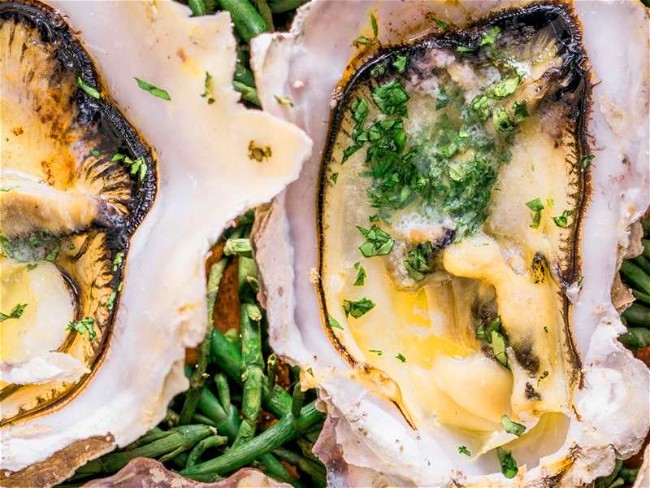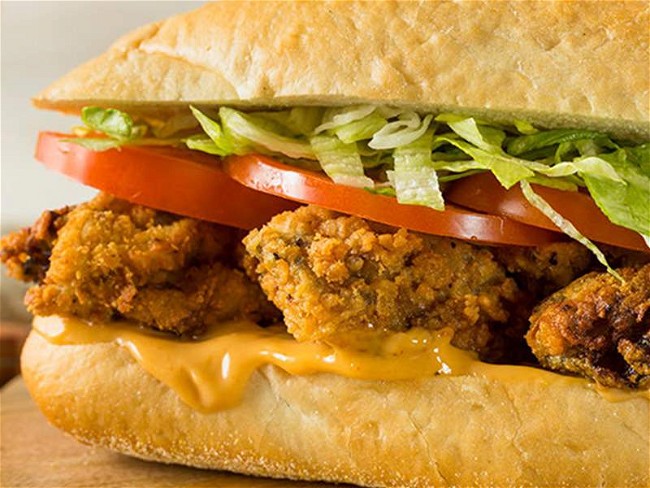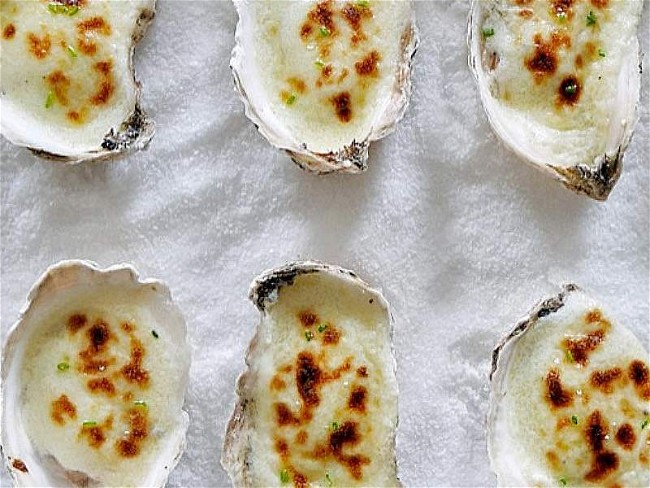Your Essential Guide to Oysters

There's nothing like knocking back a dozen (or more) ice-cold oysters. But with so many different East and West Coast oyster varieties, how do you know where to start? Our Head of Quality Control, Robert DiGregorgio, demystifies the magical world of oysters in our handy oyster guide.
“He was a bold man that first ate an oyster.” Jonathan Swift, 1667-1745.
More than most foods, oysters taste like where they come from, and in this world of mass-produced, assembly-line factory farms, that’s a good thing.
I don’t think I could eat a chicken and know where it’s from, or even a steak, a turkey, or vegetables. They all taste good to me, but there’s nothing distinctive about them.
But I can look at and eat an oyster and feel very confident about its species and generally what part of the country it comes from—East Coast, West Coast, Canadian, northern, southern, Gulf Coast. They are all different, distinct, and interesting.
Oysters draw much of their uniqueness from the land around them and the specific waters they call home. To quote Rowan Jacobsen, “They have a ‘somewhereness’ about them, like great wines.” Indeed, similar to terroir in reference to how environment greatly affects the taste and all the subtle differences of wines from the same grape, so is the same with oysters. Think of it as meroir, or terroir for oysters.
Types of Oyster Species
There are only five main oyster species commercially harvested in the United States: Crassostrea virginica, Crassostrea sikamea, Crassostrea gigas, Ostrea edulis, and Ostrea lurida.
An oyster’s flavor is so closely tied to where it comes from that they are traditionally named for that place. For example, along the entire East Coast and Gulf Coast of the U.S., the native oyster is Crassostrea virginica, the Eastern Oyster. From that one species, influenced by their unique meroir, come Beau Soleils, Pemaquids, Wellfleets, Delaware Bays, Malpeques, Blue Points, Ladies Pass, Pointe aux Pins, and Isle Dauphines to name just a (very) few. It’s the same on the West Coast. Fanny Bays, Skookums, Hood Canals, Hammersleys, Kusshis, Chef’s Creek, Emerald Cove, and many, many more are all Crassostrea gigas, the Pacific Oyster. From Ostrea lurida, we get the Olympia Oyster, a West Coast specialty. Very small and fragile, they were James Beard’s favorite. Ostrea edulis are Belon oysters. Originally from France, they were brought to Maine in the 1950s, and it wasn’t until the 1980s that significant numbers began to be produced. They are so fragile that rubber bands are wrapped around them to help them keep their shells closed. The Crassostrea sikamea is the popular Kumamoto Oyster. Native to Japan, it is now grown here in America where, according to legend, it was shipped with Pacific Oyster seed, accidentally or not, and is now very much at home in the Pacific Northwest.
What is the Difference Between Wild Oysters and Farmed Oysters?
This is a question we get asked often. Which is better? Safer? Healthier? More sustainable?
Farmed oysters, regardless of the method, are grown in the same waters as wild are (or used to be), with the main difference being that they are protected (according to the grow-out method) from predators, barnacles, dirt, and grit. They grow faster and cleaner, and their size and shape are more consistent. Though “farmed,” they are in their natural environment, albeit in cages or bags, with all the sunlight, currents, and natural food that wild oysters have access to. They are not artificially fed or given hormones or antibiotics of any kind. Farmed oysters are basically wild oysters, just a little pampered.
Oyster aquaculture is a great idea for several reasons. First, it takes pressure off the wild stocks, allowing them to repopulate. It’s also of great benefit to the aquatic environment in general. A full grown oyster can filter 50 gallons of water a day, purifying it and ridding it of silt and sediment, algae and nitrogen, contributing to the rehabilitation of waterways once uninhabitable for fish, sea plants, birds and all the sundry lifeforms part of a healthy aquatic ecosystem. They form oyster reefs, building layer upon layer of oyster shells from previous generations, creating places where fish aggregate to feed and reproduce.
In New York City, since 2014, there has been The Billion Oyster Project, restoring oyster reefs in New York Harbor, providing habitat to hundreds of species of fish while cleaning millions of gallons of water a day. These reefs also provide protection from storm surges and flood waters while also preventing erosion along the shorelines.
I think it’s in part due to the new interest in foods that are authentic, deeply connected to a place, traceable, and sustainable. But it was not uncommon years ago, at even the best restaurants, to have a very limited choice of oysters. Lundy Bros. in Sheepshead Bay in the 1950s and ’60s was one of the city’s most famous seafood restaurants. Its menu only had “Oysters on Half Shell,” “Oysters Pan Roast,” and “Oyster Stew.” No names, no identification. Furthermore, La Cote Basque, the Grande Dame of French cuisine in New York City, had “Oysters in Season” on its menu. That’s it. Sweet’s Restaurant, opened in 1842 and located next to the old Fulton Fish Market in New York City, had on its menu “Oyster Stew,” “Oyster Cocktail,” “Oysters on the Half Shell.” None of these excellent restaurants found it necessary to identify what kind of oysters they served or where they were from. Compare that now to the raw bar sections of modern menus that typically list seven or eight kinds of East Coast oysters, as well as five or six West Coast oysters. The names and locations of all these are meticulously listed, as well as flourishing descriptions of their “flavor notes.” It seems consumers these days take a much greater interest in where their food is from, how it's caught, and the overall state of the fishery itself. It took a while for some of the old-timers in the business to come around to this way of thinking, but informed consumers make better customers.
East Coast vs. West Coast Oysters
The main difference between East Coast and West Coast oysters lies in their flavor profile, size, and shape, largely influenced by the waters they grow in. Here's a breakdown:
Flavor: East Coast oysters are known for their briny, salty taste. This is due to the colder, saltier waters of the Atlantic Ocean. They often have a more complex flavor with hints of minerality, seaweed, or even vegetal notes. West Coast oysters, on the other hand, are known for their sweetness and creamier texture. The Pacific Ocean's waters are generally milder, resulting in a less salty and more subtle flavor profile with notes of melon, butter, and cucumber.
Size and Shape: East Coast oysters tend to be smaller and have a flatter, more elongated shell. They're sometimes called "cocktail" or "petite" oysters because of their size. West Coast oysters can vary in size depending on the variety, but they're generally larger and have a deeper cup shape.
Popular West Coast Oysters
- Kumamoto: Farmed, West Coast, California and Washington State. Small, at most 2” across, deep cup. Deeply fluted shells, the taste is briny at first with a sweet, creamy texture, a kind of melon-y finish. Very plump meats.
- Kusshi: Farmed, West Coast, British Columbia, Canada. Small, 2¼” across, deep cups, smooth shells. Very clean, delicate flavor.
- Fanny Bay: Farmed, West Coast. British Columbia. 3” size, briny, plump meats. Full body, a little minerally.
- Hammersley: Farmed. West Coast, Washington State. 4” across. Deep cup, meaty and full flavor, creamy, light brine, cucumber-minerally finish.
- Skookum: Farmed, West Coast. Washington State. 3-4” across. Ridged shells. Very light flavor, hardly any brine at all, creamy and herbaceous.
- Hood Canal: Farmed and wild cultivated, Washington State. 2¾” across. Fluted shells. Light brine, creamy, clean and mild. Kind of a melon-y finish. Hood Canal is a fjord that has many appellations.
- Royal Miyagi: Farmed, West Coast, Hood Canal, Washington State. 3” across, fluted shells, plump meats, medium brine, savory finish.
Popular East Coast Oysters
- Beau Soleil: Farmed, East Coast, New Brunswick, Canada. Not big, good cocktail size, 2½”, very consistent size and shape. Great starter oyster for newbie oyster fans, light flavor, medium brine, nice, clean finish. Meaty for their size.
- Sassy Malpeque: Farmed and wild, East Coast, Prince Edward Island, Canada. 3-6” across. Medium size oyster, balanced flavor, briny and sweet, deep cups and meaty. Made Prince Edward Island famous. At a culinary exhibition in Paris in 1900, Malpeque oysters were judged to be the best oyster in the world.
- Naked Cowboy: Wild, East Coast, Long Island Sound, NY. 3” across. Hand harvested. Briny, mineral accents, full plump meat, savory finish.
- Blue Point: Farmed and wild cultivated, Great South Bay and Long Island Sound, New York. 3½” across. Very popular with experienced oyster eaters. Very briny, plump and meaty, firm texture with an almost buttery, woody finish.
- Wellfleet: Farmed and wild, Cape Cod, MA. 3½” across. Clean and crisp taste, strong brine, plump meats with a seaweed finish. Most popular and well known of New England oysters.
- Pemaquid: Farmed, East Coast, Maine. 3-6” across. Meaty and briny firm texture light, sweet finish.
- Pink Moon: Farmed, Prince Edward Island, Canada. 2¾” across. Also a great starter oyster, balanced flavor, mild brininess.
- Delaware Bay: Farmed, East Coast, Delaware Bay. Up to 5” across. Two flavor profiles. The Cape Shore oysters are briny, a little astringent and slightly nutty. The Inner Bay oysters are milder.
- French Kiss: Farmed, East Coast, New Brunswick, Canada. 3½” across. Full, plump oysters. Deep cup, very clean taste. Briny, with a sweet finish.
- Duxbury XL: Farmed, Duxbury Bay, MA. 3-6” across. Unusual, oddly shaped shells, long and curvy. Plump meat, lots of liquor, briny with a sweet finish.
As popular as oysters are today, in New York City, they were once even more popular. Until the 1920s, the typical New Yorker ate an average of 600 oysters a year! These were all locally harvested from nearby bays and estuaries. These days, to entice more customers to try their oysters, producers have come up with some catchy names, such as French Kiss and Naked Cowboys. Not very descriptive, but interesting. Good marketing, really. Makes you want to order them, if just to hear yourself say it!
Are Oysters Healthy for You?
Yes, oysters are good for you, as they are an excellent source of zinc, calcium, and selenium, as well as vitamins A and B12. Low in calories and high in protein, oysters make a great addition to any healthy diet. Oysters could even help protect against heart disease due to their relatively large amounts of omega-3 fatty acids.
How Do Oysters Make Pearls?
Oysters make pearls by secreting nacre that forms into the pearl sacs. If the pearl is undesirable, the oyster puts it back out into the water, where another oyster eats it. The oyster does this over several months before the oyster dies. Oysters can be harvested before or after pearls are grown, but oysters without pearls are preferred because they have a better taste.
What Do Oysters Eat?
Oysters eat plankton and other small particles by siphoning water through their gills, trapping it in their shell to sort out what they want to eat, and then expelling water with any unwanted food bits back into the sea. An oyster's diet will vary depending on where they live; for example, some oysters feed more on phytoplankton than others since there is not as much near the shore as offshore. Oysters eat an average of 20-30% of their body weight per day.
How to Shuck Oysters
- Oysters should be held firmly but gently with a towel or thick cloth.
- Take the oyster's hinge side out of the towel and place the knife's tip on either side of the hinge.
- Slide the tip of the knife around the edge of the oyster, angling the knife toward the roof of the shell.
- Lift the top shell.
- Carefully slip the knife under the oyster's body and slice through the connective muscle connecting the body to the shell.
- The oyster is now ready to cook or eat.
For more information on how to shuck oysters at home, check out our full blog post!
Can You Eat Spawning Oysters?
We’ve all heard the old adage, “Never eat oysters in a month without an “R” in it.” Like most old proverbs or old wives tales, there is a kernel of truth in it. At one time, that might have been great advice, but these days, that old maxim doesn’t hold up. Here’s why: Oysters spawn when the waters warm up, typically in the summer months. When an oyster spawns, and for a while afterward, it is a little flimsy. The texture changes and it might not be as fat and juicy as a regular, non-spawning oyster. It's not as plump and not as flavorful as what you expect. They are perfectly safe to eat, just not the best oyster eating experience.
But spawning oysters wasn't the only reason for the admonition. Summertime and warm water bring a higher occurrence of red tides. Red tides are an out-of-control algae bloom that happens when certain currents are right, and there is an abundance of nutrients in the water. Some algae produce toxins harmful to fish and sea life. When these blooms occur it is not uncommon to see hundreds of dead fish floating on the water. Shellfish are stuck in this algae bloom and may become infected with toxins and bacteria. Eating oysters in this condition can be very harmful.
Another reason for the “R” month rule was that dealers realized oysters need their spawning season. Being left alone for the summer ensured more oysters for the future.
These reasons led to the very logical “Never eat oysters in a month without an R” rule. It made sense then, but things are much different now.
Modern-day oyster cultivation techniques, in combination with strict environmental regulations, have made it safe to eat oysters year-round. Now, there is total transparency and full accountability every step of the way during cultivation, harvesting, and shipping.
The cold chain starts the day the oysters are harvested, and they are kept refrigerated until you eat them. Water quality is constantly checked for toxins and bacteria, and no farmed oyster would ever be sold from water with less-than-safe levels. In fact, our guidelines are so strict that we cannot import oysters from the EU because their standards don’t meet ours.
So, refrigeration is much better, and strict environmental and food safety regulations are in place, but oysters still have to spawn, don’t they? Well, yes and no.
As we said, spawning is triggered by water temperature, and many oysters today are farmed in very cold water where they either don’t spawn or have a very quick spawn. Furthermore, almost half of farmed oysters today are triploids, meaning they have three sets of chromosomes and don’t reproduce at all. This is all done at the seed hatchery, and the intention of developing triploids is to meet the industry’s need for year-round marketable oysters. They grow faster than normal diploids and have more meat. To anyone without a microscope they are completely indistinguishable from regular oysters, except they don’t reproduce and don’t break down like regular oysters do after spawning.
So, the old “R” rule is a thing of the past. Oyster supply, through cultivation, is constant year round now. Environmental regulations and constant tracking of water levels and food safety laws help keep the farms clean and safe, and cultivation advancements such as triploids and quick spawning have greatly reduced or completely eliminated the time when oysters are less marketable.
For me, nothing beats knocking back a dozen or two ice cold oysters with a cold beer on a hot summer’s day.
Why Is There a Crab in My Oyster?
If you find a small crab inside oysters, this is considered lucky!
Every now and then, you may open an oyster that has a little crab inside it. Do not shriek or think you have a bad oyster! These little crabs, mainly of two species, are known colloquially as oyster crabs and/or pea crabs. Although finding one is very rare, they are a very natural guest to some oysters, mainly of the wild varieties.
We often get asked if you can still eat an oyster that has pea crabs. The answer is absolutely! You can even eat the pea crabs themselves! Believe it or not, pea crabs are considered very good eating. They are soft and have a slight crunch. Back when New York produced more oysters than anywhere, The New York Times used to run articles extolling their virtues complete with recipes for Fried Pea Crabs, Oyster Crabs on Toast, Oyster Crab Salad, etc. I kid you not!
So, what are they doing inside the oyster? The females are very delicate creatures and seek protection inside the oyster and live there permanently. The hardier males live in the water like normal crabs do, but when mating time comes around, the males seek out an oyster and knock until it opens up. Well, actually, they stroke it in their special pea crab way, and when the oyster opens up a little, they scoot in and mate with the female. Then it leaves and goes walking on its way until it finds another likely oyster and knocks on that one to see if anyone is home. Not all oysters have these little crabs; it’s almost always a wild oyster and only a fraction of those, so you may never see one. But if you find a pea crab in your oyster, consider yourself lucky! If you’re feeling a little adventurous, try eating it. You might just be surprised.
When are Oysters In Season?
Oysters can be consumed all year round, although oysters from different areas will vary in taste and texture. Oysters grown in colder waters tend to be meatier and harder than oysters grown in warmer waters. The oyster season extends from September through April, and peak oyster consumption occurs during the winter months.
Are Oysters an Aphrodisiac?
Which brings me to another question we get asked all the time. Will oysters help your love life? Well, you’re on your own with this one. I say take your chances!
Our Best Oyster Recipes
Get your grill on with our easy grilled oysters recipe - don't forget the crusty bread to mop up all the delicious garlic parsley butter! Don't have a grill? Don't worry! Our recipe works for broiled oysters, too.
Golden, crispy fried oysters stuffed into fresh bread rolls and slathered with a punchy remoulade sauce is the taste of New Orleans. Let the good times roll!
Truffle Bechamel Oysters Recipe
We think oysters are perfect on their own, but this truffle béchamel oyster recipe adds a luxurious decadence to your oyster happy hour. We think Beau Soleils are a great oyster choice for this recipe.



